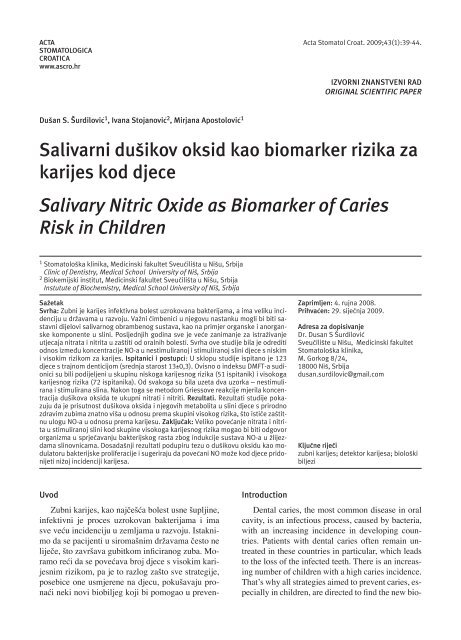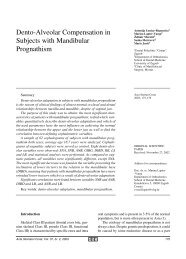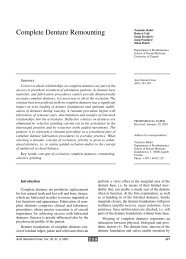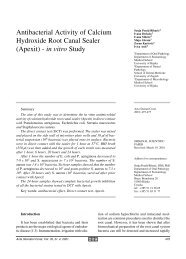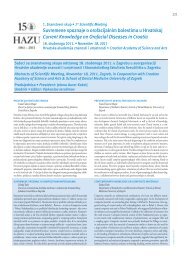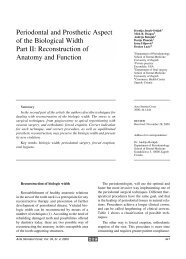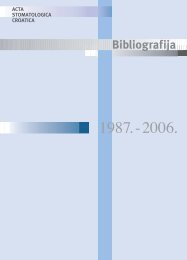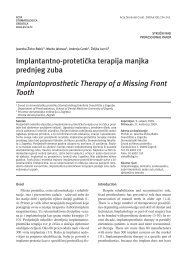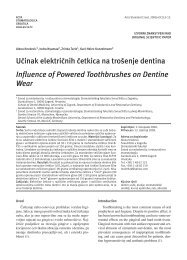Salivarni dušikov oksid kao biomarker rizika za karijes kod djece ...
Salivarni dušikov oksid kao biomarker rizika za karijes kod djece ...
Salivarni dušikov oksid kao biomarker rizika za karijes kod djece ...
Create successful ePaper yourself
Turn your PDF publications into a flip-book with our unique Google optimized e-Paper software.
ACTA<br />
STOMATOLOGICA<br />
CROATICA<br />
www.ascro.hr<br />
Dušan S. Šurdilović 1 , Ivana Stojanović 2 , Mirjana Apostolović 1<br />
Acta Stomatol Croat. 2009;43(1):39-44.<br />
IZVORNI ZNANSTVENI RAD<br />
ORIGINAL SCIENTIFIC PAPER<br />
<strong>Salivarni</strong> <strong>dušikov</strong> <strong>oksid</strong> <strong>kao</strong> <strong>biomarker</strong> <strong>rizika</strong> <strong>za</strong><br />
<strong>karijes</strong> <strong>kod</strong> <strong>djece</strong><br />
Salivary Nitric Oxide as Biomarker of Caries<br />
Risk in Children<br />
1 Stomatološka klinika, Medicinski fakultet Sveučilišta u Nišu, Srbija<br />
Clinic of Dentistry, Medical School University of Niš, Srbija<br />
2 Biokemijski institut, Medicinski fakultet Sveučilišta u Nišu, Srbija<br />
Instutute of Biochemistry, Medical School University of Niš, Srbija<br />
Sažetak<br />
Svrha: Zubni je <strong>karijes</strong> infektivna bolest uzrokovana bakterijama, a ima veliku incidenciju<br />
u državama u razvoju. Važni čimbenici u njegovu nastanku mogli bi biti sastavni<br />
dijelovi salivarnog obrambenog sustava, <strong>kao</strong> na primjer organske i anorganske<br />
komponente u slini. Posljednjih godina sve je veće <strong>za</strong>nimanje <strong>za</strong> istraživanje<br />
utjecaja nitrata i nitrita u <strong>za</strong>štiti od oralnih bolesti. Svrha ove studije bila je odrediti<br />
odnos između koncentracije NO-a u nestimuliranoj i stimuliranoj slini <strong>djece</strong> s niskim<br />
i visokim rizikom <strong>za</strong> <strong>karijes</strong>. Ispitanici i postupci: U sklopu studije ispitano je 123<br />
<strong>djece</strong> s trajnom denticijom (srednja starost 13±0,3). Ovisno o indeksu DMFT-a sudionici<br />
su bili podijeljeni u skupinu niskoga <strong>karijes</strong>nog <strong>rizika</strong> (51 ispitanik) i visokoga<br />
<strong>karijes</strong>nog <strong>rizika</strong> (72 ispitanika). Od svakoga su bila uzeta dva uzorka – nestimulirana<br />
i stimulirana slina. Nakon toga se metodom Griessove reakcije mjerila koncentracija<br />
<strong>dušikov</strong>a <strong>oksid</strong>a te ukupni nitrati i nitriti. Rezultati. Rezultati studije pokazuju<br />
da je prisutnost <strong>dušikov</strong>a <strong>oksid</strong>a i njegovih metabolita u slini <strong>djece</strong> s prirodno<br />
zdravim zubima znatno viša u odnosu prema skupini visokog <strong>rizika</strong>, što ističe <strong>za</strong>štitnu<br />
ulogu NO-a u odnosu prema <strong>karijes</strong>u. Zaključak: Veliko povećanje nitrata i nitrita<br />
u stimuliranoj slini <strong>kod</strong> skupine visokoga <strong>karijes</strong>nog <strong>rizika</strong> mogao bi biti odgovor<br />
organizma u sprječavanju bakterijskog rasta zbog indukcije sustava NO-a u žlijezdama<br />
slinovnicama. Dosadašnji rezultati podupiru tezu o <strong>dušikov</strong>u <strong>oksid</strong>u <strong>kao</strong> modulatoru<br />
bakterijske proliferacije i sugeriraju da povećani NO može <strong>kod</strong> <strong>djece</strong> pridonijeti<br />
nižoj incidenciji <strong>karijes</strong>a.<br />
Uvod<br />
Zubni <strong>karijes</strong>, <strong>kao</strong> najčešća bolest usne šupljine,<br />
infektivni je proces uzrokovan bakterijama i ima<br />
sve veću incidenciju u zemljama u razvoju. Istaknimo<br />
da se pacijenti u siromašnim državama često ne<br />
liječe, što <strong>za</strong>vršava gubitkom inficiranog zuba. Moramo<br />
reći da se povećava broj <strong>djece</strong> s visokim <strong>karijes</strong>nim<br />
rizikom, pa je to razlog <strong>za</strong>što sve strategije,<br />
posebice one usmjerene na djecu, pokušavaju pronaći<br />
neki novi biobiljeg koji bi pomogao u preven-<br />
Introduction<br />
Zaprimljen: 4. rujna 2008.<br />
Prihvaćen: 29. siječnja 2009.<br />
Adresa <strong>za</strong> dopisivanje<br />
Dr. Dusan S Šurdilović<br />
Sveučilište u Nišu, Medicinski fakultet<br />
Stomatološka klinika,<br />
M. Gorkog 8/24,<br />
18000 Niš, Srbija<br />
dusan.surdilovic@gmail.com<br />
Ključne riječi<br />
zubni <strong>karijes</strong>; detektor <strong>karijes</strong>a; biološki<br />
biljezi<br />
Dental caries, the most common disease in oral<br />
cavity, is an infectious process, caused by bacteria,<br />
with an increasing incidence in developing countries.<br />
Patients with dental caries often remain untreated<br />
in these countries in particular, which leads<br />
to the loss of the infected teeth. There is an increasing<br />
number of children with a high caries incidence.<br />
That’s why all strategies aimed to prevent caries, especially<br />
in children, are directed to find the new bio-
40 Šurdilović i sur.<br />
ciji bolesti. Važni čimbenici u sprječavanju nastanka<br />
<strong>karijes</strong>a mogli bi biti sastavni dijelovi salivarnog<br />
obrambenog sustava, tj. organske i anorganske<br />
komponente u slini. Veće <strong>za</strong>nimanje <strong>za</strong> tu mogućnost<br />
potaknule su spoznaje o različitosti i međudjelovanju<br />
mnogih <strong>za</strong>štitnih tvari u slini. Posljednjih<br />
godina raste <strong>za</strong>nimanje <strong>za</strong> ulogu nitrata i nitrita u<br />
<strong>za</strong>štiti protiv oralnih bolesti (1,2).<br />
Ljudska usna šupljina okolina je s neprekinutom<br />
opskrbom koncentriranih nitrata, a oni su metabolički<br />
produkt <strong>dušikov</strong>a <strong>oksid</strong>a (NO-a). U usnoj<br />
šupljini <strong>dušikov</strong> <strong>oksid</strong> i nitriti te stabilni metaboliti<br />
NO-a potječu ili iz fiziološke redukcije prehrambenih<br />
nitrata ili od reakcije L-arginina kataliziranih<br />
inducibilnom nitričnom <strong>oksid</strong>nom sintazom (iNOSom)<br />
enzima izraženom u žlijezdama slinovnicama i<br />
epitelnim stanicama izvodnih kanala koji mogu biti<br />
stimulirani preko proupalnih podražaja (3-6).<br />
Premda se već nekoliko godina <strong>dušikov</strong> <strong>oksid</strong><br />
(NO) i njegovi metabolički produkti - nitrati i nitriti,<br />
povezuju sa štetnim utjecajem na ljude, nedavni<br />
dokazi upućuju na povoljne antimikrobne učinke<br />
NO-a u oralnoj šupljini (7).<br />
Svrha ove studije bila je odrediti <strong>kod</strong> <strong>djece</strong> odnos<br />
ukupne koncentracije nitrata i nitrita u nestimuliranoj<br />
i stimuliranoj slini, u odnosu prema njihovu<br />
niskom i visokom <strong>karijes</strong>nom riziku.<br />
Ispitanici i postupci<br />
Ispitivana skupina sastojala se od 123 <strong>djece</strong> s<br />
trajnom denticijom (srednja dob 13,4±0,3). Svi sudionici<br />
bili su dobrog općeg zdravlja, bez drugih<br />
zubnih i oralnih bolesti te nisu uzimali nikakve lijekove<br />
koji bi mogli utjecati na sastav sline. Protokol<br />
studije odobrilo je lokalno Etičko povjerenstvo, a<br />
ispitanici i njihovi roditelji dali su suglasnost.<br />
U skladu s kriterijima WHO-a, stomatološki status<br />
i razinu <strong>karijes</strong>a <strong>kod</strong> svih je ispitanika odredila<br />
ista osoba koristeći se indeksom DMFT-a. Ovisno o<br />
tome ispitanici su bili podijeljeni u dvije skupine -<br />
jednu s DMFT-om 0, to je bila skupina LCR (djeca<br />
s niskim <strong>karijes</strong>nim rizikom –51 sudionik) i druga s<br />
DMFT-om 7,7 (djeca s visokim <strong>karijes</strong>nim rizikom<br />
– 72 ispitanika) – to je bila skupina HCR. Slina se<br />
skupljala nakon doručka. Od svih se <strong>za</strong>htijevalo da<br />
se najmanje tri sata prije nego što daju uzorak sline<br />
suzdrže od hrane i pića te da se ne koriste osvježivačem<br />
daha. U sterilnim epruvetama skupljeno je<br />
Biomarker <strong>karijes</strong>nog <strong>rizika</strong> <strong>kod</strong> <strong>djece</strong><br />
markers which could help in prevention of this disease.<br />
The significant factors in caries could be the elements<br />
of salivary defense system, i.e. organic and<br />
inorganic compounds present in saliva. Deep interest<br />
in these aspects grew out of the findings about<br />
the diversity and orchestration of the many protective<br />
agents in saliva. In the course of the last years<br />
there has been a growing interest in the role of nitrates<br />
and nitrites in protection against oral diseases<br />
(1,2).<br />
Human oral cavity represents the environment<br />
with a constant supply of concentrated nitrates, the<br />
metabolic products of nitric oxide (NO). In oral cavity<br />
NO and nitrite, the stable NO metabolite, originate<br />
either from physiological reduction of dietary<br />
nitrates or from L-arginine undergoing the reaction<br />
catalyzed by inducible nitric oxide synthase (iN-<br />
OS), the enzyme expressed in salivary glands and<br />
duct epithelial cells which may be induced by proinflammatory<br />
stimuli (3-6).<br />
Although for many years nitric oxide and its metabolical<br />
products, nitrates and nitrites, have been<br />
associated with deleterious effects in humans, the<br />
recent evidence has suggested the beneficial antimicrobial<br />
role of NO in oral cavity (7).<br />
The aim of the present study was to determine<br />
the relationship between total nitrate + nitrite concentration<br />
in unstimulated and stimulated saliva of<br />
children in correspondence to low and high caries<br />
risk.<br />
Material and Methods<br />
The study group consisted of 123 children with<br />
permanent dentition, with the mean age 13.4±0.3.<br />
All examined subjects were in good general health,<br />
without other dental and oral diseases and not taking<br />
the medications that might affect saliva composition.<br />
The study protocol was approved by the local<br />
ethical commitee and the subjects and their parents<br />
gave their informed consent.<br />
Following the WHO criteria, the state of dentition<br />
and the level of caries in all individuals were<br />
determined by the same person, using DFMT index.<br />
According to DFMT index, the subjects were<br />
divided into two examined groups: one group with<br />
DFMT - 0 (children with low caries risk – 51 subjects)<br />
– LCR group, and, the other with mean DFMT<br />
– 7.7 (children with high caries risk – 72 subjects)<br />
– HCR group.<br />
Saliva was collected after breakfast. The subjects<br />
were instructed to refrain from eating, drink-
Šurdilović et al. Biomarker of Caries Risk in Children 41<br />
bilo 2,0 do 2,5 ml sline. Od svakog ispitanika uzeta<br />
su dva uzorka – nestimulirana i stimulirana slina.<br />
Uzorci nestimulirane sline bili su iz sline u usnoj šupljini,<br />
a uzorci stimulirane sline uzeti su nakon što<br />
je ispitanik pet minuta žva<strong>kao</strong> sterilni parafin, što je<br />
povećalo sekreciju.<br />
Uzorci sline najprije su filtrirani kako bi se uklonile<br />
epitelne stanice i ostale čestice. Svaki filtrat bio<br />
je <strong>za</strong>mrznut jedan sat prije nastavka obrade. Koncentracija<br />
NO-a te nitrata i nitrita (NO 2 +NO 3 ) bila<br />
je izmjerena metodom Griessove reakcije (8).<br />
Nakon deproteini<strong>za</strong>cije ocijenjeno je stvaranje <strong>dušikov</strong>a<br />
<strong>oksid</strong>a i to mjerenjem koncentracije nitrita.<br />
Premda se nitrati u kadmijskoj redukciji transformiraju<br />
u nitrite, oni su mjereni neposredno<br />
spektrofotometrijski na 543 nm koristeći se kolorimetrijskom<br />
metodom prema Griessu (Griess reagens:<br />
1,5 % sulfanilamide u 1 M HCl uz 0,15 %<br />
N- (1-naphthyl)ethylendiamine dihydrokloride u<br />
destiliranoj vodi). Izračunati su srednja vrijednost<br />
i standardna devijacija te su podaci analizirani jednovarijantnom<br />
analizom varijance (SPSS verzija<br />
10,0).<br />
Rezultati<br />
Slike 1. i 2. prikazuju koncentracije NO 2 +NO 3<br />
<strong>kod</strong> nestimulirane (UWS) i stimulirane (SWS) sline<br />
<strong>djece</strong> s niskim i visokim <strong>karijes</strong>nim rizikom te upućuju<br />
na veliku razliku između UWS-a i SWS-a.<br />
Razine UWS-a u skupini LCR znatno su više<br />
(252,22 ± 47,9 µmol/L; p
42 Šurdilović i sur.<br />
µmol/L<br />
Slika 1. NO 2 +NO 3 koncentracije u slini <strong>kod</strong> skupine niskog<br />
<strong>karijes</strong>nog <strong>rizika</strong> (LCR-a); *** p
Šurdilović et al. Biomarker of Caries Risk in Children 43<br />
skupine HCR-a. Visoka incidencija <strong>karijes</strong>a pove<strong>za</strong>na<br />
je s povećanjem NO-a <strong>kod</strong> skupine UWS-a. Obrnuti<br />
omjer između LCR i HCR koncentracije NOa<br />
u stimuliranoj slini testiranih ispitanika <strong>za</strong>htijeva<br />
indukciju salivarnog iNOS-a u tim uvjetima. Dobiveni<br />
rezultati podupiru ulogu NO-a <strong>kao</strong> modulatora<br />
bakterijske proliferacije i sugeriraju da povećanje<br />
<strong>dušikov</strong>a <strong>oksid</strong>a može pridonijeti manjoj incidenciji<br />
<strong>karijes</strong>a <strong>kod</strong> <strong>djece</strong>. To je u skladu s rezultatima Carossa<br />
i suradnika – oni su predložili <strong>dušikov</strong> <strong>oksid</strong><br />
<strong>kao</strong> dio obrane u bakterijskoj proliferaciji u zubnom<br />
plaku (17).<br />
Ako uzmemo u obzir rezultate Silva-Mende<strong>za</strong><br />
i njegovih kolega koji navode mogućnost da nitriti<br />
iz sline imaju snažan utjecaj na rast i preživljavanje<br />
kariogenih bakterija te dobro poznatu činjenicu<br />
da manjak sline pridonosi zubnom <strong>karijes</strong>u, smatramo<br />
da bi količina <strong>dušikov</strong>a <strong>oksid</strong>a u slini mogla biti<br />
važan čimbenik u obrani domaćina od mikroorgani<strong>za</strong>ma<br />
koji potiču tu bolest (18). Zubni <strong>karijes</strong><br />
poseban je problem <strong>kod</strong> <strong>djece</strong> te bi se mogla postaviti<br />
hipote<strong>za</strong> da je veći unos nitrata u toj skupini<br />
važan u suprimiranju bakterijskog rasta i <strong>za</strong>to štiti<br />
zube od <strong>karijes</strong>a. Ako se uzme u obzir nepravilna<br />
uporaba prehrambenih nitrata, potrebno je istaknuti<br />
kako je doka<strong>za</strong>no da se njihove koncentracije u<br />
plazmi ne mijenjaju prije nitratnog obroka i poslije<br />
njega (19). Na osnovi pretpostavke da nitrati u hrani<br />
loše djeluju na ljudsko zdravlje donedavno ih se<br />
smatralo vrlo štetnima, ali epidemiološke studije nisu<br />
uspjele to potvrditi. Doka<strong>za</strong>no je da se prehrambeni<br />
nitrati podvrgavaju enterosalivarnoj cirkulaciji<br />
- recirkuliraju se u krv, koncentriraju u žlijezdama<br />
slinovnicama, izlučuju sa slinom i reduciraju u nitrite<br />
uz pomoć fakultativnih gram-pozitivnih anaeroba<br />
(Staphylococcus sciuri i S. intermedius) na jeziku.<br />
<strong>Salivarni</strong> nitriti gutanjem se prenose u «kiseli»<br />
želudac gdje se reduciraju u velike količine <strong>dušikov</strong>a<br />
<strong>oksid</strong>a i ostalih <strong>oksid</strong>a dušika te vjerojatno pridonose<br />
stvaranju sistemskih S-<strong>dušikov</strong>ih soli i ulja.<br />
Premda su prehrambeni nitrati koji određuju produkciju<br />
skupine <strong>dušikov</strong>ih <strong>oksid</strong>a u želucu sve važniji<br />
u učinkovitoj obrani od gastrointerstinalnih patogena,<br />
oni su i modulator palete aktivnosti i možda<br />
čak promotori gasrtointerstinalne pokretljivosti i<br />
mikrocirkulacije (20).<br />
Ova studija jedna je od rijetkih u kojoj je obrađen<br />
problem sline <strong>kod</strong> <strong>djece</strong> s trajnom denticijom te<br />
se došlo do podataka koji bi mogli znatno utjecati<br />
na spoznaje o važnosti prehrane u redukciji incidencije<br />
<strong>karijes</strong>a u djetinjstvu.<br />
incidence of caries is associated with the increase<br />
of NO in UWS. The opposite ratio between LCR<br />
and HCR stimulated whole saliva NO of tested subject<br />
suggests the induction of salivary iNOS in these<br />
conditions. The obtained results support the role of<br />
NO as modulator of bacterial proliferation and suggest<br />
that increased NO production might contribute<br />
to lower caries incidence in children. This is in accordance<br />
with the results of Carossa et al. (17), who<br />
suggested the role of NO in the defense against bacterial<br />
proliferation in dental plaque.<br />
Considering the results of Silva-Mendez et al.<br />
(18), which demonstrate the possibility that nitrite<br />
in saliva has a dramatic effect on cariogenic bacteria<br />
growth and survival, and the well known fact<br />
that the impairment of saliva excretion promotes<br />
dental caries, we believe that the amount of NO<br />
in saliva could be an important factor of host defense<br />
mechanisms against caries-producing microorganisms.<br />
Dental caries is a particular problem in<br />
children, so it could be hypothesized that increased<br />
nitrate intake in this group may be important in supressing<br />
the growth of bacteria and thereby protecting<br />
the teeth against caries. Taking into account the<br />
misuse of dietary nitrates, it is neccessary to mention<br />
that it has been proved that plasma nitrite concentrations<br />
pre and post nitrate meal were unmodified<br />
(19). Based on the premise that dietary nitrate<br />
is detrimental to human health, until recently nitrate<br />
has been perceived as a purely harmful dietary component,<br />
but epidemiological studies have failed to<br />
substantiate this. It has been shown that dietary nitrate<br />
undergoes enterosalivary circulation. It is recirculated<br />
in the blood, concentrated by the salivary<br />
glands, secreted in the saliva and reduced to nitrite<br />
by facultative Gram-positive anaerobes (Staphylococcus<br />
sciuri and S. intermedius) on the tongue.<br />
Salivary nitrite is swallowed into the acidic stomach<br />
where it is reduced to large quantities of NO<br />
and other oxides of N and, conceivably, also contributes<br />
to the formation of systemic S-nitrosothiols.<br />
Thus, nitrate in the diet, which determines reactive<br />
nitrogen oxide species production in the stomach, is<br />
emerging as an effective host defence against gastrointestinal<br />
pathogens, as a modulator of platelet<br />
activity and possibly even of gastrointestinal motility<br />
and microcirculation (20).<br />
This study is one of few studies that investigate<br />
this problem in the saliva of children with permanent<br />
dentition, obtaining the results with the possible<br />
implications to dietary influence on caries incidence<br />
reduction in childhood.
44 Šurdilović i sur.<br />
Zahvala<br />
Zahvaljujemo <strong>za</strong> tehničku potporu i pomoć inženjerki<br />
kemije Svetlani Stojanović s Biokemijskog<br />
instituta Medicinskog fakulteta Sveučilišta u Nišu.<br />
References<br />
1. Duncan C, Li H, Dykhuizen R, Frazer R, Johnston P, MacKnight<br />
G, et al. Protection against oral and gastrointestinal<br />
diseases: importance of dietary nitrate intake, oral<br />
nitrate reduction and enterosalivary nitrate circulation.<br />
Comp Biochem Physiol A Physiol. 1997;118(4):939-48.<br />
2. Bayindir YZ, Polat MF, Seven N. Nitric oxide concentrations<br />
in saliva and dental plaque in relation to caries experience<br />
and oral hygiene. Caries Res. 2005;39(2):130-3.<br />
3. Olin AC, Aldenbratt A, Ekman A, Ljungkvist G, Jungersten L,<br />
Alving K, et al. Increased nitric oxide in exhaled air after intake<br />
of a nitrate-rich meal. Respir Med. 2001;95(2):153-8.<br />
4. Moncada S, Higgs A. The L-arginine-nitric oxide pathway.<br />
N Engl J Med. 1993;329(27):2002-12.<br />
5. Green SJ. Nitric oxide in mucosal immunity. Nat Med.<br />
1995;1(6):515-7.<br />
6. Soinila J, Nuorva K, Soinila S. Nitric oxide synthase<br />
in human salivary glands. Histochem Cell Biol.<br />
2006;125(6):717-23.<br />
7. Doel JJ, Hector MP, Amirtham CV, Al-An<strong>za</strong>n LA, Benjamin<br />
N, Allaker RP. Protective effect of salivary nitrate and microbial<br />
nitrate reductase activity against caries. Eur J Oral<br />
Sci. 2004;112(5):424-8.<br />
8. Navarro-Gonzálvez JA, García-Benayas C, Arenas J. Semiautomated<br />
measurement of nitrate in biological fluids.<br />
Clin Chem. 1998;44(3):679-81.<br />
9. Mancinelli RL, McKay CP. Effects of nitric oxide and nitrogen<br />
dioxide on bacterial growth. Appl Environ Microbiol.<br />
1983;46(1):198-202.<br />
10. Li H, Duncan C, Townend J, Killham K, Smith LM, Johnston<br />
P, et al. Nitrate-reducing bacteria on rat tongues. Appl<br />
Environ Microbiol. 1997;63(3):924-30.<br />
11. Lundberg JO, Weitzberg E, Cole JA, Benjamin N. Nitrate,<br />
bacteria and human health. Nat Rev Microbiol.<br />
2004;2(7):593-602.<br />
Acknowledgement<br />
Abstract<br />
Purpose: Dental caries is an infectious process, caused by bacteria, with an increasing<br />
incidence in developing countries. The significant factors in caries could be the elements<br />
of salivary defense system, i.e. organic and inorganic compounds present in<br />
saliva. The last years there has been a growing interest in the role of nitrates and nitrites<br />
in protection against oral diseases. The aim of the present study was to determine<br />
the relationship between NO concentration in unstimulated and stimulated saliva<br />
of children with low and high caries risk. Material and Methods: The study group<br />
consisted of 123 children with permanent dentition (the mean age 13.4±0.3). According<br />
to DFMT index, the subjects were divided into low (51 subjects) and high caries<br />
risk group (72 subjects). Two saliva samples were taken from each subject – unstimulated<br />
and stimulated one. Nitric oxide concentration was measured as total nitrates<br />
and nitrites by the Griess reaction method. Results: The results of this study show that<br />
the presence of NO and its metabolites in saliva of children with natural healthy teeth<br />
is significantly higher compared to high risk group, suggesting the protective role of<br />
NO in relation to caries. Conclusions: The highly significant increase of nitrates and nitrites<br />
in stimulated saliva of high caries risk group could be the host defense response<br />
opposing bacterial growth, due to induction of iNOS in salivary glands. The obtained<br />
results support the role of NO as modulator of bacterial proliferation and suggest that<br />
increased NO production might contribute to lower caries incidence in children.<br />
Biomarker <strong>karijes</strong>nog <strong>rizika</strong> <strong>kod</strong> <strong>djece</strong><br />
We are grateful for the technical support and<br />
help to Mrs. Svetlana Stojanović, engineer of chemistry<br />
at the Institute of Biochemistry, Medical Faculty,<br />
University of Niš.<br />
Received: September 4, 2008<br />
Accepted: January 29, 2009<br />
Address for correspondence<br />
Dr. Dusan S Šurdilović<br />
University of Niš, Medical School<br />
Clinic of Dentistry,<br />
M. Gorkog 8/24,<br />
18000 Nis, Srbija<br />
dusan.surdilovic@gmail.com<br />
Key words<br />
Dental Caries; Caries Detector; Biological<br />
Markers<br />
12. Radcliffe CE, Akram NC, Hurrell F, Drucker DB. Effects<br />
of nitrite and nitrate on the growth and acidogenicity of<br />
Streptococcus mutans. J Dent. 2002;30(7-8):325-31.<br />
13. Wink DA, Kaspr<strong>za</strong>k KS, Maragos CM, Elespuru RK, Misra<br />
M, Dunams TM, et al. DNA deaminating ability and<br />
genotoxicity of nitric oxide and its progenitors. Science.<br />
1991;254(5034):1001-3.<br />
14. Reddy D, Lancaster JR Jr, Cornforth DP. Nitrite inhibition<br />
of Clostridium botulinum: electron spin resonance<br />
detection of iron-nitric oxide complexes. Science.<br />
1983;221(4612):769-70.<br />
15. Hogg N, Darley-Usmar VM, Wilson MT, Moncada S. Production<br />
of hydroxyl radicals from the simultaneous generation<br />
of superoxide and nitric oxide. Biochem J. 1992;281<br />
(Pt 2):419-24.<br />
16. Lorsbach RB, Murphy WJ, Lowenstein CJ, Snyder SH, Russell<br />
SW. Expression of the nitric oxide synthase gene in<br />
mouse macrophages activated for tumor cell killing. Molecular<br />
basis for the synergy between interferon-gamma and<br />
lipopolysaccharide. J Biol Chem. 1993;268(3):1908-13.<br />
17. Carossa S, Pera P, Doglio P, Lombardo S, Colagrande P,<br />
Brussino L, et al. Oral nitric oxide during plaque deposition.<br />
Eur J Clin Invest. 2001;31(10):876-9.<br />
18. Silva Mendez LS, Allaker RP, Hardie JM, Benjamin N. Antimicrobial<br />
effect of acidified nitrite on cariogenic bacteria.<br />
Oral Microbiol Immunol. 1999;14(6):391-2.<br />
19. Pannala AS, Mani AR, Spencer JP, Skinner V, Bruckdorfer<br />
KR, Moore KP, et al. The effect of dietary nitrate on salivary,<br />
plasma, and urinary nitrate metabolism in humans.<br />
Free Radic Biol Med. 2003;34(5):576-84.<br />
20. McKnight GM, Duncan CW, Leifert C, Golden MH. Dietary nitrate<br />
in man: friend or foe? Br J Nutr. 1999;81(5):349-58.


